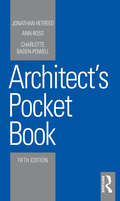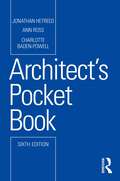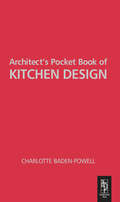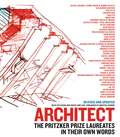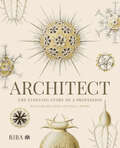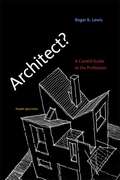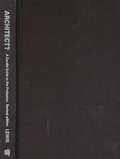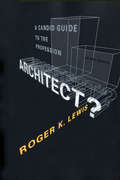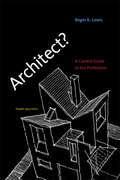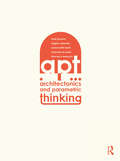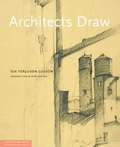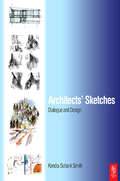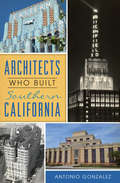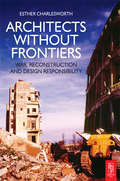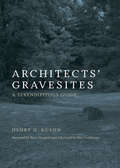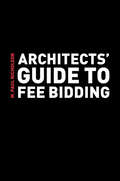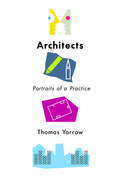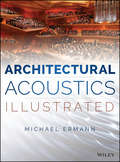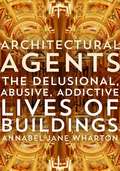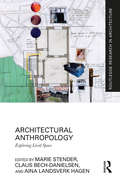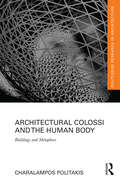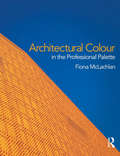- Table View
- List View
Architect's Pocket Book (Routledge Pocket Books)
by Jonathan Hetreed Ann Ross Charlotte Baden-PowellThis handy pocket book brings together a wealth of useful information that architects need on a daily basis – on-site or in the studio. It provides clear guidance and invaluable detail on a wide range of issues, from planning policy through environmental design to complying with Building Regulations, from structural and services matters to materials characteristics and detailing. This fifth edition includes the updating of regulations, standards and sources across a wide range of topics. Compact and easy to use, the Architect’s Pocket Book has sold well over 90,000 copies to the nation’s architects, architecture students, designers and construction professionals who do not have an architectural background but need to understand the basics, fast. This is the famous little blue book that you can’t afford to be without.
Architect's Pocket Book (Routledge Pocket Books)
by Jonathan Hetreed Ann Ross Charlotte Baden-PowellThis handy pocket book brings together a wealth of useful information that architects need on a daily basis – on-site or in the studio. It provides clear guidance and invaluable detail on a wide range of issues, from planning policy through environmental design to complying with Building Regulations, from structural and services matters to materials characteristics and detailing. This sixth edition includes the updating of regulations, standards and sources across a wide range of topics, with a particular focus on sustainability issues. Compact and easy to use, the Architect’s Pocket Book has sold well over 100,000 copies to the nation’s architects, architecture students, designers and construction professionals who do not have an architectural background but need to understand the basics, fast. This is the famous little blue book that you can’t afford to be without.
Architect's Pocket Book of Kitchen Design (Routledge Pocket Books)
by Charlotte Baden-PowellAs with the best-selling 'Architects Pocket Book' this title includes everyday information which the architect/designer normally has to find from a wide variety of sources and which is not always easily to hand.Focusing on kitchen design, this book is of use to the student as well as the experienced practitioner. It outlines all the information needed to design a workable kitchen, including ergonomics, services such as water and waste, appliances, and material choices for the floor, walls and ceiling. There is no similar compendium currently available.
Architect: The Pritzker Prize Laureates in Their Own Words
by Ruth Peltason Grace Ong YanIn this completely revised and up-to-date edition, the world's most accomplished architects-Gehry, Pei, Meier, Nouvel, Piano, and 37 more-express their views on creativity, inspiration, and legacy in this visually stunning, one-of-a-kind collection.The Pritzker Prize is the most prestigious international prize for architecture. Architect includes all 42 recipients of the Pritzker Prize, and captures in pictures and their own words their awe-inspiring achievements. Organized in reverse chronological order by laureate each chapter features four to six of the architect's major works, including museums, libraries, hotels, places of worship, and more. The text, culled from notebooks, interviews, articles, and speeches illuminates the architects' influences and inspirations, personal philosophy, and aspirations for his own work and the future of architecture. The book includes More than 1000 stunning photographs, blueprints, sketches, and CAD drawings.Architect offers an unprecedented view into the minds of some of the most creative thinkers, dreamers, and builders of the last three decades and reveals that buildings are political, emotional, and spiritual.
Architect: The evolving story of a profession
by Eleanor Jolliffe Paul CrosbyThe architect’s role is constantly adapting. Throughout history it has shifted significantly, shaped by social, cultural, technological and economic forces. The very definition of what an architect is and does has evolved over time from lead builder or master mason to principal designer. A collaborative and reactive profession, it is inextricably linked to the power of the patron, whether the client is an influential and affluent individual or a political, commercial, civic or religious organisation. From Ancient Egypt, where architects were members of the ruling class, tied into the running of the empire, to the 21st century when questions are being raised about the future of the profession, this book, with its engaging narrative, explores the constant threads that remain as the profession adapts. While architects are no longer deified, their ability to imagine a new impending reality in built form implies a visionary dimension to their work. By focusing on both the practicalities of the profession and the more intangible motivations behind design – humans’ need to make a mark upon their surroundings – this volume provides a critical overview of over 3000 years of practice and education. Looking at the key questions of where the architectural profession originated in the Western tradition, why it is, how it is today and where it might be going next, the authors postulate that architects’ ability to adapt and reinvent themselves in the past will stand them in good stead for the uncertainties of the future.
Architect?
by Roger K. LewisSince 1985, "Architect?" has been an essential text for aspiring architects, offering the best basic guide to the profession available. This third edition has been substantially revised and rewritten, with new material covering the latest developments in architectural and construction technologies, digital methodologies, new areas of focus in teaching and practice, evolving aesthetic philosophies, sustainability and green architecture, and alternatives to traditional practice. "Architect?" tells the inside story of architectural education and practice; it is realistic, unvarnished, and insightful. Chapter 1 asks "Why Be an Architect?" and chapter 2 offers reasons "Why Not to Be an Architect. " After this provocative beginning, Architect? goes on to explain and critique architectural education, covering admission, degree and curriculum types, and workload as well as such post-degree options as internship, teaching, and work in related fields. It offers a detailed discussion of professors and practitioners and the "-isms" and "-ologies" most prevalent in teaching and practicing architecture. It explains how an architect works and gets work, and describes architectural services from initial client contact to construction oversight. The new edition also includes a generous selection of drawings and cartoons from the authors Washington Post column, "Shaping the City," offering teachable moments wittily in graphic form. The author, Roger Lewis, has taught, practiced, and written extensively about architecture for many years. In "Architect?" he explains -- for students, professors, practitioners, and even prospective clients -- how architects think and work and what they care about as they strive to make the built environment more commodious, more beautiful, and more sustainable.
Architect? A Candid Guide to the Profession
by Roger K. LewisThis revised edition includes new information pertinent to current education and practice and addresses issues and concerns of great interest to students choosing among different types of programs, schools, firms, and architectural career paths.
Architect? A Candid Guide to the Profession, revised and expanded edition: A Candid Guide To The Profession (The\mit Press Ser.)
by Roger K. LewisThis revised edition of the best basic guide to the architectural profession includes new information pertinent to current education and practice and addresses issues and concerns of great interest to students choosing among different types of programs, schools, firms, and architectural career paths.The first edition of Architect?, published in 1985, quickly became known as the best basic guide to the architectural profession. More than a decade later, it is a standard text for introductory courses on architecture and recommended reading on the application forms of many schools of architecture. This revised edition includes new information pertinent to current education and practice and addresses issues and concerns of great interest to students choosing among different types of programs, schools, firms, and architectural career paths.Roger K. Lewis, a practicing architect and educator, takes a hard look at the education of the architect as he covers such topics as curriculum content, pedagogical theories and methods, program and faculty types, the admission process, internship, compensation, computer-aided design, and the culture of small and large firms. He tells how an architect works and gets work, and explains all aspects of architectural services, from initial client contact to construction oversight.The author describes the benefits of becoming an architect, including the opportunity to express oneself creatively, to improve the environment, and to achieve notoriety. But he doesn't hesitate to show the other side—the lack of steady work and appropriate compensation, the intensity of competition, the restrictions imposed by clients, and the high degree of anxiety and disillusionment among young architects. Written in a clear, accessible style, the book is accompanied by the authors often-humorous illustrations and a valuable appendix.
Architect?, third edition: A Candid Guide to the Profession (The\mit Press Ser.)
by Roger K. LewisThe new edition of an essential text offers an informative, engaging view of the architectural profession from education through practice.Since 1985, Architect? has been an essential text for aspiring architects, offering the best basic guide to the profession available. This third edition has been substantially revised and rewritten, with new material covering the latest developments in architectural and construction technologies, digital methodologies, new areas of focus in teaching and practice, evolving aesthetic philosophies, sustainability and green architecture, and alternatives to traditional practice. Architect? tells the inside story of architectural education and practice; it is realistic, unvarnished, and insightful. Chapter 1 asks “Why Be an Architect?” and chapter 2 offers reasons “Why Not to Be an Architect.” After this provocative beginning, Architect? goes on to explain and critique architectural education, covering admission, degree and curriculum types, and workload as well as such post-degree options as internship, teaching, and work in related fields. It offers a detailed discussion of professors and practitioners and the “-isms” and “-ologies” most prevalent in teaching and practicing architecture. It explains how an architect works and gets work, and describes architectural services from initial client contact to construction oversight. The new edition also includes a generous selection of drawings and cartoons from the author's Washington Post column, “Shaping the City,” offering teachable moments wittily in graphic form.The author, Roger Lewis, has taught, practiced, and written extensively about architecture for many years. In Architect? he explains—for students, professors, practitioners, and even prospective clients—how architects think and work and what they care about as they strive to make the built environment more commodious, more beautiful, and more sustainable.
Architectonics and Parametric Thinking: Computational Modeling for Beginning Design
by Frank Jacobus Rachel Smith Loerts Angie Carpenter Antonello Di Nunzio Francesco BedeschiThis book is an approachable guide for students and professionals to learn parametric modeling through the lens of architectonics, allowing readers to pair fundamental ideas about architecture with parametric thinking. Architectonics and Parametric Thinking begins by clearly positioning the potentials of parametric design through a series of chapters written by leaders in their respective industries. This helps to situate the vast potential of parametric softwares, allowing the reader to understand the full range of what is made possible by working computationally. Following this theoretical introduction, the book presents a manual that walks readers through the step-by-step construction of parametric modeling scripts built through an architectonic lens using clear, compelling diagrams. Each of these diagrams provide textual accompaniment that describes how each new portion of the script is transforming the algorithm as a whole, as well as diagrams that show the physical transformation that is taking place as a result of the script’s evolution. Parametric modeling is radically transforming the design disciplines and will become the primary way designer’s generate new products moving forward. Written and expertly designed for architecture students and professionals, this book provides an interactive approach to teaching the basics of parametric thinking in relation to architecture and design.
Architectonics of Poiēsis: Architectural Creation Reconsidered (Numanities - Arts and Humanities in Progress #29)
by Simina Anamaria LörinczThis volume explores the meaning of the architectural creative act, following the dynamics of the relationship between creator-creative act-creation and the way in which architecture is defined over time, as a creative act both material and symbolic. Two protagonists, Antonio Averlino (Filarete) and Christopher Alexander, are singled out under the guiding concepts of poíēsis and poeta faber. The book initiates a dialogue over time between their works and concepts, engaging two cultures, the Renaissance and the contemporary, symbolically chosen for their importance in redefining the profession through the prism of its relation to the architectural creative act. The core idea revolves around rediscovering the humanistic approach to architecture in and for the contemporary context, and using it in order to better understand architectural creation. This text appeals to students and researchers working in the history and theory of architecture, product, industrial design, and semiotics.
Architects Draw
by Sue Ferguson GussowArchitects Draw, the inaugural volume of the Architectural Brief series, translates much-loved Cooper Union professor and artist Sue Gussow's freehand drawing class into a portable tool for teachers and students in professional architecture programs. After a foreword by the noted critic Dore Ashton, Part I sets forth a complete syllabus for a foundational freehand drawing program. Part II includes a discussion of pedagogical philosophy and Part III illustrates how freehand drawing is carried into professional, postgraduate life.
Architects Sketches
by Kendra Schank SmithConcepts from architects’ minds evolve through sketches and as a mode of transference are conveyed to the finished building. This book compares qualities of sketches to reveal unique approaches to the instruments of thinking in which all architects engage. It provides new insight into the relationship between architectural sketches and the process of creative manipulation. Sketches comprise a thinking mechanism, and through the qualities of ambiguity, quickness and change, they initiate a dialogue for architects. As a medium to facilitate communication, recording, discovery and evaluation, their pertinence lies in their ability to exhibit both the precise and the imprecise. Exploring four related theoretical approaches, play, memory-imagination-fantasy, caricature and the grotesque, the book shows how imprecision stimulates imagination to conceive new forms in the dialogue of architectural sketches.
Architects Who Built Southern California
by Antonio GonzalezIn the early 1900s, the population of Southern California exploded, and the cities grew at such a rapid pace that builders could hardly keep up. Among those who settled in the area were ten architects looking to make their marks on the world. Claud Beelman, a man who never received a college degree, would go on to design the Elks Lodge in Los Angeles. Albert C. Martin, architect of Grauman's Million Dollar Theater, founded a company that is still going strong more than one hundred years later, and Julia Morgan, the first woman architect licensed in California, was hired by William Randolph Hearst to design the Examiner Building. Join author Antonio Gonzalez as he tells the stories of the people behind some of Southern California's most iconic buildings.
Architects Without Frontiers
by Esther CharlesworthFrom the targeted demolition of Mostar’s Stari-Most Bridge in 1993 to the physical and social havoc caused by the 2004 Boxing Day Tsunami, the history of cities is often a history of destruction and reconstruction. But what political and aesthetic criteria should guide us in the rebuilding of cities devastated by war and natural calamities? The title of this timely and inspiring new book, Architects Without Frontiers, points to the potential for architects to play important roles in post-war relief and reconstruction. By working “sans frontières”, Charlesworth suggests that architects and design professionals have a significant opportunity to assist peace-making and reconstruction efforts in the period immediately after conflict or disaster, when much of the housing, hospital, educational, transport, civic and business infrastructure has been destroyed or badly damaged. Through selected case studies, Charlesworth examines the role of architects, planners, urban designers and landscape architects in three cities following conflict - Beirut, Nicosia and Mostar - three cities where the mental and physical scars of violent conflict still remain. This book expands the traditional role of the architect from 'hero' to 'peacemaker' and discusses how design educators can stretch their wings to encompass the proliferating agendas and sites of civil unrest.
Architects' Gravesites: A Serendipitous Guide (The\mit Press Ser.)
by Henry H. KuehnAn illustrated guide to the monumental and non-monumental final resting places of famous architects from Aalto Alvar to Frank Lloyd Wright.All working architects leave behind a string of monuments to themselves in the form of buildings they have designed. But what about the final spaces that architects themselves will occupy? Are architects' gravesites more monumental—more architectural—than others? This unique book provides an illustrated guide to more than 200 gravesites of famous architects, almost all of them in the United States. Led by our intrepid author, Henry Kuehn, we find that most graves of architects are not monumental but rather modest, that many architects did not design their final resting places, and that a surprising number had their ashes scattered.Architects' Gravesites offers an alphabetical listing, from Alvar Aalto and Dankmar Adler (Louis Sullivan's partner) to Frank Lloyd Wright and Minoru Yamasaki (designer of the Word Trade Center's twin towers). Each entry includes a brief note on the architect's career and a color photograph of the site. For example, Ludwig Mies van der Rohe is buried in Chicago under a simple granite slab designed by his architect grandson; Louise Bethune, the first American woman to become a professional architect, is buried under a headstone inscribed only with her husband's name (a plaque honoring her achievements was installed later); Philip Johnson's ashes were spread in his rose garden, with no marker, across the street from his famous Glass House; and the grave of Pierre L'Enfant in Arlington National Cemetery offers a breathtaking view of Washington, D.C., the city he designed. Architects' Gravesites is an architectural guide like no other, revealing as much about mortality as about monumentality.
Architects' Guide to Fee Bidding
by M. Paul NicholsonFee bidding still generates emotive reactions from within many sections of the architectural profession. Fee bidding is not taught in most schools of architecture, so practitioners generally rely on hunches and guesswork. It is these wild card guesses, which exacerbate the poor levels of income for which the architectural profession is renowned. This book introduces practising architects, architectural managers and senior students, to the philosophy and practice of analytical estimating for fees. By means of a detailed case study it illustrates the many problems which may be encountered in the calculation of fees for professional services. It gives a step-by-step guide through the complexities of fee bidding and acts as a source of reference to successful bidding. A detailed discussion of the philosophy of design management and architectural management is developed as a backdrop to the preparation of a bid. It leads the reader through the mysteries of converting the calculation of a bid into a serious tender. This unique text is an essential guide for all practitioners, particularly those at the commencement of their careers and Part 3 students. Indeed it will be of importance to all constructional professionals who operate within a highly competitive market.
Architects: Portraits of a Practice (Expertise: Cultures and Technologies of Knowledge)
by Thomas YarrowWhat is creativity? What is the relationship between work life and personal life? How is it possible to live truthfully in a world of contradiction and compromise? These deep and deeply personal questions spring to the fore in Thomas Yarrow's vivid exploration of the life of architects. Yarrow takes us inside the world of architects, showing us the anxiety, exhilaration, hope, idealism, friendship, conflict, and the personal commitments that feed these acts of creativity. Architects rethinks "creativity," demonstrating how it happens in everyday practice. It highlights how the pursuit of good architecture, relates to the pursuit of a good life in intimate and individually specific ways. And it reveals the surprising and routine social negotiations through which designs and buildings are actually made.
Architectural Acoustics (PocketArchitecture)
by Ana M Jaramillo Chris SteelThe application of good acoustic design can seem daunting to designers when trying to understand the often-complex physics of sound control. The ever-increasing number of standards and performance criteria that can be requested on new developments further complicates acoustics for architects. Architectural Acoustics, part of the PocketArchitecture series, provides the fundamental theory and understanding of acoustics and applications of effective detailing for specific building types and conditions in an accessible and clear technical guide. The book provides: a compact and understandable introduction to the fundamentals of building and architectural acoustics definitions of suitable acoustic performance criteria for a wide range of common buildings and room types guidance on specification and detailing of the most suitable construction types in North America and the UK. This book is both, a handy rule of thumb on acoustics for anyone involved in the design or construction of buildings, as well as an essential addition to any architect’s reference library.
Architectural Acoustics Illustrated
by Michael A. ErmannUnite the science of sound and the principles of design to enhance any spaceArchitectural Acoustics Illustrated translates the quantitative and qualitative content of acoustics into the graphic language of architecture. This highly-visual guide includes over 350 illustrations that outline the physics of sound and the best design practices for limiting or mitigating noise in buildings by using the latest in materials and techniques. Each chapter includes a summary checklist of design guidelines to help prevent mistakes and oversights, and the Instructor's website offers video animations demonstrating acoustical concepts. Designed as a "first look" at the interaction of sound and space, the book explains the principles of architectural acoustics and their practical applications, providing a comprehensive guide for designing with acoustics in mind.Architectural acoustics is more than just concert halls - it may determine building placement, division of interior space, exterior construction, and even siting. When addressed early in the design process, the resulting space can be free of unwanted sound and promote good hearing; if left unaddressed, the problems with the space can lead to lawsuits and costly post-construction remediation. Architectural Acoustics Illustrated helps designers solve most acoustical problems in advance, by enabling readers to:Understand the physical science underlying the behavior of soundConsider the interactions of sound and space in the initial design approachMitigate building sounds such as those produced by HVAC and plumbing with early design planningDesign spaces for listening, and incorporate acoustics best practices into every planThe highly visual format of the book helps readers grasp complex concepts quickly, and thorough discussion of each concept's real-world application ties the science directly into the design process. All design professionals need to have a fundamental understanding of acoustics, and Architectural Acoustics Illustrated is a comprehensive, practical guide in an easy-to-read format.
Architectural Acoustics: A guide to integrated thinking
by Raj PatelThis book is an authoritative but uniquely accessible and highly illustrated guide to good acoustic design practice for architects, interior designers and acoustic professionals. It provides a user-friendly introduction to architectural acoustics and acoustics technology where the market is crowded with dense and technical texts. It will go through each typology in turn explaining the key acoustic concepts with highly illustrated and international case studies that demonstrate cutting-edge practice and technology, innovative design techniques and common challenges and solutions.
Architectural Agents: The Delusional, Abusive, Addictive Lives of Buildings
by Annabel Jane WhartonBuildings are not benign; rather, they commonly manipulate and abuse their human users. Architectural Agents makes the case that buildings act in the world independently of their makers, patrons, owners, or occupants. And often they act badly. Treating buildings as bodies, Annabel Jane Wharton writes biographies of symptomatic structures in order to diagnose their pathologies. The violence of some sites is rooted in historical trauma; the unhealthy spatial behaviors of other spaces stem from political and economic ruthlessness. The places examined range from the Cloisters Museum in New York City and the Palestine Archaeological Museum (renamed the Rockefeller Museum) in Jerusalem to the grand Hostal de los Reyes Católicos in Santiago de Compostela, Spain, and Las Vegas casino resorts. Recognizing that a study of pathological spaces would not be complete without an investigation of digital structures, Wharton integrates into her argument an original consideration of the powerful architectures of video games and immersive worlds. Her work mounts a persuasive critique of popular phenomenological treatments of architecture. Architectural Agents advances an alternative theorization of buildings&’ agency—one rooted in buildings&’ essential materiality and historical formation—as the basis for her significant intervention in current debates over the boundaries separating humans, animals, and machines.
Architectural Anthropology: Exploring Lived Space (Routledge Research in Architecture)
by Marie StenderThis book prompts architects and anthropologists to think and act together. In order to fully grasp the relationship between human beings and their built environments and design more livable and sustainable buildings and cities in the future, we need new cross-disciplinary approaches combining anthropology and architecture. This is neither anthropology of architecture, nor ethnography for architects, but a new approach beyond these positions: Architectural Anthropology. The anthology gathers contributions from leading researchers from various Nordic universities, architectural schools, and architectural firms as well as prominent international scholars like Tim Ingold, Albena Yaneva, and Sarah Pink – all exploring, developing, and innovating the cross-disciplinary field between anthropology and architecture. Several contributions are co-written by architects and anthropologists, merging approaches from the two disciplines in order to fully explore the dynamics of lived space. Through a broad range of empirical examples, methodological approaches, and theoretical reflections, the anthology provides inspiration and tools for scholars, students, and practitioners working with lived space. The first part focusses on homes, walls, and boundaries, the second on urban space and public life, and the third on processes of creativity, participation, and design.
Architectural Colossi and the Human Body: Buildings and Metaphors (Routledge Research in Architecture)
by Charalampos PolitakisThe human body has been used as both a model and metaphor in architecture since antiquity. This book explores how it has been an inspiration for the exterior form of architectural colossi through the years. It considers the body as a source of architectural and artistic representation and in doing so explores the results of such practices in colossal sculptures and architectural praxis within a philosophical discourse of space, time and media. Architectural Colossi and the Human Body discusses the role of Platonic and Cartesian philosophy and how philosophers such as Heidegger and Merleau-Ponty, and theoreticians such as Frascari and Pallasmaa, have seen, described and analysed the human body and the role of architecture and perception. Drawing upon three key case studies and by employing theoretical ideas of Venturi and others, this book will provide an understanding of the role of anthromorphism and the relation and use of the human body with reference to selected architects and artists.
Architectural Colour in the Professional Palette
by Fiona McLachlanHow do architects use color? Do they adopt a different strategy or starting point for every project? Do they gradually cultivate individual color palettes, which develop alongside their body of built work? Do they utilize, or are they aware of, the body of theoretical work that underpins the use of color in the past, and forms the basis of most of the color systems commercially available today? Informed by the author’s thirty years in architectural practice and academia, this book investigates, documents and analyzes the work of a number of contemporary architects in order to respond to these questions and provide a clear reference of contemporary color use. The book suggests a holistic approach to the integration of color in architecture; through a series of thematic essays, the text explores and reveals underlying principles in color design and application. Case studies include: AHMM Caruso St John Erich Wiesner and Otto Steidle Gigon/Guyer O’Donnell + Tuomey Sauerbruch Hutton Steven Holl UN Studio. The book provides clear insights into how particular contemporary architects use color confidently and intelligently as an integral part of their design philosophy, in conjunction with their choices of materials and finishes. Offering a stimulating view of the history of color theory, and pragmatic advice to practicing architects, this book will be inspiring to both design professionals and students.
